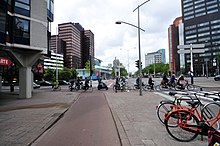A protected intersection or protected junction, also known as a Dutch-style junction, is a type of at-grade road junction in which cyclists and pedestrians are separated from cars. The primary aim of junction protection is to help pedestrians and cyclists be and feel safer at road junctions.[1]
At a conventional junction, pedestrians are separated from motor vehicles, while cyclists are placed in the carriageway with motorists. Cycle lanes are often placed on the nearside (right in right-side driving countries; left in left-side countries) of the carriageway, which can create conflict, for example when a cyclist is going straight ahead and a motorist is turning to the nearside.[1]
At a protected junction, vehicles turning to the nearside are separated from crossing cyclists and pedestrians by a buffer, providing increased reaction times and visibility. Drivers looking to turn to the nearside have better visibility of cyclists and pedestrians as they can look to the side for conflicts instead of over their shoulders. At unsignalised intersections, it is practice to have one car length of space between the cycleway and roadway, so that cars exiting the minor street have an area to pull forward and wait for a gap in traffic, without becoming distracted by potential simultaneous conflicts along the cyclepath.

This type of intersection has for decades been used in the bicycle-friendly Netherlands, and Denmark. An alternative philosophy, design for vehicular cycling, encourages having bicycle lanes simply disappear, or "drop", at intersections, forcing riders to merge into traffic like a vehicle operator ahead of the intersection in order to avoid the risk of a right-hook collision, when a right turning motorist collides with a through moving cyclist. Design policies which do not allow the cyclist to remain separated through the intersection have come under increasing scrutiny in recent years as causing difficulties for less capable riders,[2] leading to lower overall ridership and sidewalk riding,[3][4] and being less safe.[5]
- ^ a b Richard Butler, Jonathan Salter, Dave Stevens, Brian Deegan (July 2019). Greater Manchester’s cycling and walking network: CYCLOPS – Creating Protected Junctions. [1]
- ^ Dill, Jennifer; McNeil, Nathan (2016-01-01). "Revisiting the Four Types of Cyclists: Findings from a National Survey". Transportation Research Record. 2587: 90–99. doi:10.3141/2587-11. S2CID 114945037.
- ^ "Prospect Park West Traffic Calming and Bicycle Path Page 12" (PDF).
- ^ "Designing for All Ages and Abilities. Page 2" (PDF). NACTO.
- ^ Buehler, Ralph; Pucher, John (2021-01-02). "The growing gap in pedestrian and cyclist fatality rates between the United States and the United Kingdom, Germany, Denmark, and the Netherlands, 1990–2018". Transport Reviews. 41 (1): 48–72. doi:10.1080/01441647.2020.1823521. ISSN 0144-1647. S2CID 225108005.
© MMXXIII Rich X Search. We shall prevail. All rights reserved. Rich X Search
